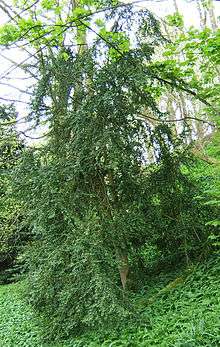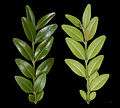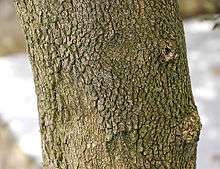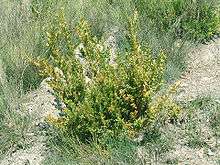Buxus sempervirens
Buxus sempervirens, the common box, European box, or boxwood, is a species of flowering plant in the genus Buxus, native to western and southern Europe, northwest Africa, and southwest Asia, from southern England south to northern Morocco, and east through the northern Mediterranean region to Turkey.[1][2][3] Buxus colchica of western Caucasus and B. hyrcana of northern Iran and eastern Caucasus are commonly treated as synonyms of B. sempervirens.[4][5]
| Buxus sempervirens | |
|---|---|
 | |
| Mature specimen | |
| Scientific classification | |
| Kingdom: | Plantae |
| Clade: | Tracheophytes |
| Clade: | Angiosperms |
| Clade: | Eudicots |
| Order: | Buxales |
| Family: | Buxaceae |
| Genus: | Buxus |
| Species: | B. sempervirens |
| Binomial name | |
| Buxus sempervirens | |
 | |
| Distribution range of Buxus sempervirens | |
Description
Buxus sempervirens is an evergreen shrub or small tree growing up to 1 to 9 m (3 to 30 ft) tall, with a trunk up to 20 centimetres (8 in) in diameter (exceptionally to 10 m tall and 45 cm diameter[6]). Arranged in opposite pairs along the stems, the leaves are green to yellow-green, oval, 1.5–3 cm long, and 0.5–1.3 cm broad. The hermaphrodite flowers are inconspicuous but highly scented, greenish-yellow, with no petals, and are insect pollinated; the fruit is a three-lobed capsule containing 3-6 seeds.[1][3]
Distribution and habitat
The species typically grows on soils derived from chalk, limestone, usually as an understorey in forests of larger trees, most commonly associated with European beech (Fagus sylvatica) forests, but also sometimes in open dry montane scrub, particularly in the Mediterranean region. Box Hill, Surrey is named after its notable box population, which comprises the largest area of native box woodland in England.[7][8]
The species is locally naturalised in parts of North America.[9]
Cultivation

In Britain, four Roman burials featured coffins containing sprays of the evergreen box, a practice unattested elsewhere in Europe. Box leaves have also been found from several towns, villas and farmsteads in Roman Britain, indicating ornamental planting. [10]
Box remains a very popular ornamental plant in gardens, being particularly valued for topiary and hedges because of its small leaves, evergreen nature, tolerance of close shearing, and scented foliage. The scent is not to everyone's liking: the herbalist John Gerard found it "evill and lothsome" and Daniel Defoe recounts that at Hampton Court Palace Queen Anne had the box hedging removed because she found its odour offensive.[11]
In the American South, it has sometimes been called "rich man's hedge,"[12] and was often used to anchor the landscape plantings on either side of the front door of a house. The scent, most pungent on warm summer days, is not found disagreeable by all, despite its having been likened to cat urine.
Several cultivars have been selected, including 'Argenteo-variegata' and 'Marginata' with variegated foliage; such "gilded box" received a first notice in John Parkinson's Paradisi in Sole Paradisus Terrestris (1629).[13] 'Vardar Valley', a slow-growing particularly hardy semi-dwarf cultivar,[14][15] was selected in 1935 by the American botanist Edward Anderson in the upper Vardar valley and sent to the Arnold Arboretum for evaluation.[16]
The following varieties and cultivars have gained the Royal Horticultural Society's Award of Garden Merit:-
Pests and diseases
A pest which spreads through Buxus sempervirens is Cydalima perspectalis, the box tree moth.
- Infested box tree.
- Detail of the defoliation.
- Larva.
 Adults.
Adults.
Uses
Timber
.jpg)
Slow growth of box renders the wood ("boxwood") very hard (possibly the hardest in Europe) and heavy, and free of grain produced by growth rings, making it ideal for cabinet-making, the crafting of flutes and oboes, engraving, marquetry, woodturning, tool handles, mallet heads and as a substitute for ivory. The British wood-engraver Thomas Bewick pioneered the use of boxwood blocks for wood-engraving.[3][15][19]
Medicinal plant
The leaves were formerly used in place of quinine, and as a fever reducer.[19]
 Foliage
Foliage Flowers
Flowers Bark of B. sempervirens 'Arborescens'
Bark of B. sempervirens 'Arborescens' Plant growing in dry Mediterranean scrub
Plant growing in dry Mediterranean scrub
Buxus sempervirens is a medicinal plant used to treat many diseases. It contains steroidal alkaloids such as cyclobuxine.[20][21] It also contains flavonoids.[22]
B. sempervirens wasn’t known for its medical use until the beginning of the 1600s.[23] After this it was found that the leaves (containing alkaloids, oils and tannin), the bark (containing chlorophyll, wax, resin, lignin and minerals) and the oil from the wood had a medical effect.[24] It then was used to treat gout, urinary tract infections, intestinal worms, chronic skin problems, syphilis, hemorrhoids, epilepsy, headache and piles,[25] but also had the reputation of curing leprosy, rheumatism, HIV, fever and malaria.[26][27] For treating malaria it was used as a substitute for quinine, but because of the side effects and the fact that there are better medicinal alternatives than B. sempervirens it is normally not used any more to treat these diseases.[28]
Homoeopathy still made use of the leaves against rheumatism, HIV and fever[29] by brewing tea from them.[30] In Turkey, where the plant is called Adi şimşir, this tea (one glass a day) is still consumed for antihelminthic, diaphoretic, and cholagogue purposes.[31] Also, the leaves from B. sempervirens were used as an auburn hair dye.[32] The plant Buxus sempervirens has been well investigated chemically. During late 1980s, Dildar Ahmed while working on his PhD thesis under the supervision of Prof Atta-ur-Rahman, isolated a number of steroidal alkaloids from the leaves of the plant. A new system of nomenclature for buxus alkaloids was also proposed based on buxane nucleus. He also isolated a flavonoid glycoside, and named it galactobuxin based on the fact that it contains a galactose ring.
References
- Rushforth, K. (1999). Trees of Britain and Europe. Collins ISBN 0-00-220013-9.
- Flora Europaea: Buxus sempervirens
- British Trees: Buxus sempervirens Archived 2006-11-10 at the Wayback Machine
- "Buxus sempervirens". Germplasm Resources Information Network (GRIN). Agricultural Research Service (ARS), United States Department of Agriculture (USDA). Retrieved 15 December 2017.
- Med-Checklist: Buxus colchica
- Tree Register of the British Isles
- Mitchell, A. F. (1974). A Field Guide to the Trees of Britain and Northern Europe. Collins ISBN 0-00-212035-6
- Bean, W. J. (1976). Trees and Shrubs Hardy in the British Isles 8th ed., vol. 1. John Murray ISBN 0-7195-1790-7.
- "PLANTS Profile". Retrieved 2007-03-14.
- Lodwick, Lisa A. (2017). "Evergreen Plants in Roman Britain and Beyond: Movement, Meaning and Materiality". Britannia. 48: 135–173. doi:10.1017/S0068113X17000101. ISSN 0068-113X.
- Defoe, A Tour Thro' the Whole Island of Great Britain (1724), noted in Todd Longstaffe-Gowan and Vivian Russell, The Gardens and Parks at Hampton Court Palace (2005:87); the authors suggest that simplification of the Dutch designs to suit an English taste for plain lawn and gravel was the major motive (pp 84ff).
- http://www.boxwoodsociety.org/uploads/22_2_1982_October.pdf
- Parkinson asserts in his Theatrum Botanicum (1640) that the "gilded" box "hath not been mentioned by any Writer before me": quoted in Alice M. Coats, Garden Shrubs and Their Histories (1964) 1992, s.v. "Buxus".
- Huxley, A., ed. (1992). New RHS Dictionary of Gardening. Macmillan ISBN 0-333-47494-5.
- Plants for a Future: Buxus sempervirens
- John L. Creech, note in Coats 1992.
- "RHS Plant Selector - Buxus sempervirens 'Elegantissima'". Retrieved 15 April 2020.
- "RHS Plant Selector - Buxus sempervirens 'Latifolia Maculata'". Retrieved 15 April 2020.
- Pg.171, Lawrence, E., ed. (1985) The Illustrated Book of Trees & Shrubs. Gallery Books ISBN 0-8317-8820-8.
- Ahmed, D; Choudhary, M. I; Turkoz, S; Sener, B (1988). "Chemical Constituents of Buxus sempervirens". Planta Medica. 54 (2): 173–4. doi:10.1055/s-2006-962384. PMID 17265235.
- Robert, M.W. (1998). Alkaloids: Biochemistry, Ecology, and Medicinal Applications.
- Atta-Ur-Rahman; Ahmed, Dildar; Asif, Erfan; Ahmad, Sultan; Sener, Bilge; Turkoz, Songul (1991). "Chemical Constituents of Buxus sempervirens". Journal of Natural Products. 54: 79. doi:10.1021/np50073a003.
- Garden, U.o.O.B. Buxus sempervirens-The Virtues. Available from: http://www.botanic-garden.ox.ac.uk/buxus-sempervirens.html Archived 2016-05-05 at the Wayback Machine.
- Sturluson, T. Health Benefits of Boxwood and Side Effects. 2015; Available from: http://www.herbal-supplement-resource.com/boxwood.html.
- Williamson, E.M., Potter’s Herbal Cyclopaedia. 2003, Essex: Saffron Walden.
- Barceloux, D.G., Medical Toxicology of Natural Substances: Foods, Fungi, Medicinal Herbs, Plants and Venomous Animals. John Wiley & Sons, 2008.
- Rahman, A.-u. and M.I. Choudhary, Chapter 2 Chemistry and Biology of Steroidal Alkaloids, in The Alkaloids: Chemistry and Biology, A.C. Geoffrey, Editor. 1998,
- Neves, J.M., et al., Ethnopharmacological notes about ancient uses of medicinal plants in Tras-os-Montes (northern of Portugal). Journal of Ethnopharmacology, 2009. 124(2): p. 270-283.
- Baumgärtner, B. Buchsbaum (Buxus sempervirens). Available from: http://www.natwiss.ph-karlsruhe.de/GARTEN/material/steckbrief/Giftpflanzen/buchsbaum_ph-ka.pdf Archived 2018-11-23 at the Wayback Machine.
- Ramona, V. Pflanzenfreunde. Available from: http://www.pflanzenfreunde.com/hausmittel/fieber-senken.htm.
- Baytop, T., Therapy with Medicinal Plants in Turkey (past and present). Istanbul University Publications, 1999. No: 3255.
- Bown, D., The Royal Horticultural Society new encyclopedia of herbs and their uses. 2002, London :: Dorling Kindersley.
| Wikimedia Commons has media related to Buxus sempervirens. |